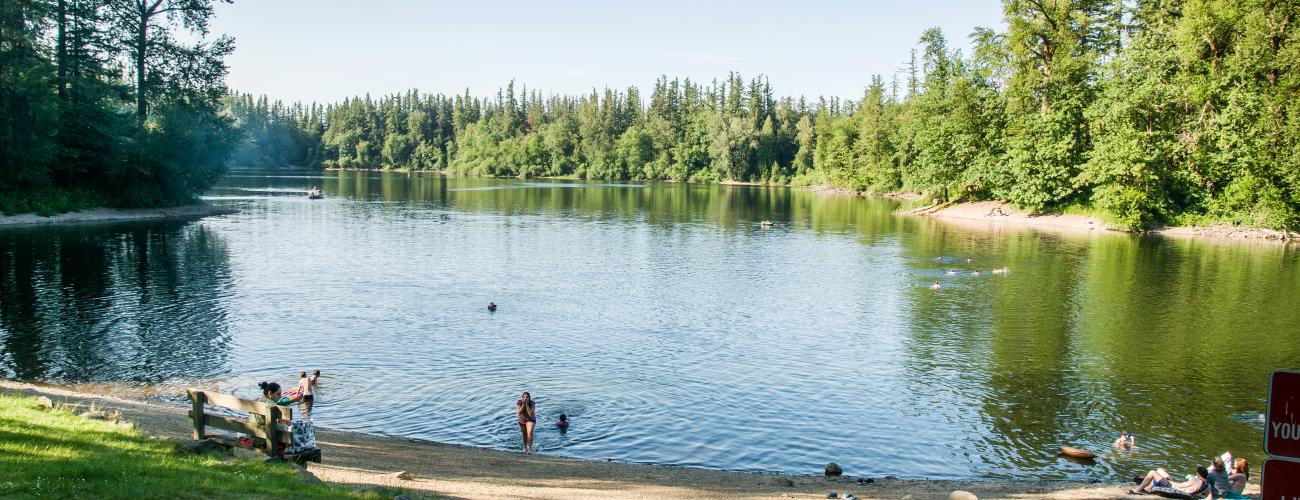Nolte State Park History
Nolte State Park preserves a forest sanctuary surrounding Deep Lake, favored for swimming and picnicking on hot summer days. The lake’s attractively cool waters are due to its 76-foot depth and cold water coming into the lake from Deep Creek, with its headwaters in the 3,000-foot-high foothills of the Cascade Mountains.
The lake has no outlet, as outflow percolates through gravels left as meltwater outwash from the great Ice Age glaciers that filled the Puget Sound lowlands.
Deep Lake itself may have been excavated by the same Ice Age glacier as it plowed through previously deposited outwash, or the lake may have occupied a sunken “kettle,” a depression formed as ice blocks buried by sediment slowly melted.
Exposures of bedrock east and west of the lake contain coal seams that fueled a coal mining boom in the area.
Indigenous Lands
Nolte State Park lies within the traditional territories of Coast Salish Indigenous people whose present-day descendants include members of the Muckleshoot Indian Tribe, Snoqualmie Indian Tribe, and Confederated Tribes and Bands of the Yakama Nation.
For thousands of years the lands around today’s Nolte State Park have provided habitat for a diverse community of life that forms the basis of their cultures, especially around the harvest, preservation and stewardship of salmon in the Green River. Traditionally, resource gathering was performed with temporary summer residences at specific resource sites and larger permanent winter villages in locations protected from cold-season weather.
Local tribes ceded ownership of the area to the US federal government under duress in the Treaty of Point Elliot in 1855, keeping rights to harvest natural resources in their usual and accustomed places including the area of today’s Nolte State Park.
Land Distribution
Government surveys of the area were completed in 1881, and most of the land in today’s Nolte State Park passed into private ownership as part of the Northern Pacific Railroad (NP) Land Grant. The US Congress had approved the grant in 1864, which eventually conveyed nearly 40 million acres of public domain lands to subsidize the construction of railroad lines into the western states. The land surrounding Deep Lake was sold to other private owners, as were most of the granted lands.
A land parcel including the southern edge of Deep Lake was purchased by Frederick Nolte in 1889 as a Cash Entry patent, a type of sale of public domain lands. Nolte also purchased the former NP grant lands surrounding the lake.
Frederick Nolte was a mining engineer and developer who opened several coal mines in the area, including the Naval and Sunset mines near Cumberland, just east of today’s Nolte State Park. Frederick died in 1909, leaving the land to his five children.
Deep Lake Resort
In the early years of the 20th century, mobility and leisure time increased along with a rapid population increase in western Washington. Many people desired to leave their urban and suburban homes for recreation experiences in surrounding rural areas.
Frederick’s son William saw the opportunity to develop Deep Lake for visitors and opened the Deep Lake Resort in 1913. To offer a competitive edge to attract visitors to the park, he built a dance hall that extended over the water, as well as a floating high jump platform for thrill-seekers.
After William died in 1930, his sister Minnie Nolte, a Seattle nurse, continued operation of the resort with a concessionaire.
Creating a State Park
Minnie Nolte died on July 27, 1971, at the age of 89. In her will, she bequeathed the Deep Lake Resort to the Washington State Parks and Recreation Commission (WSPRC). The will stated that the land should be used “for the benefit of the public and especially, and if possible, for children and young people.” Additionally, the gift stipulated that the park should be named Nolte State Park.
On September 13, 1971, the WSPRC formally accepted the property as a part of the Washington State Park system.
Sharing the histories of Washington’s state parks is an ongoing project. Learn more here.

